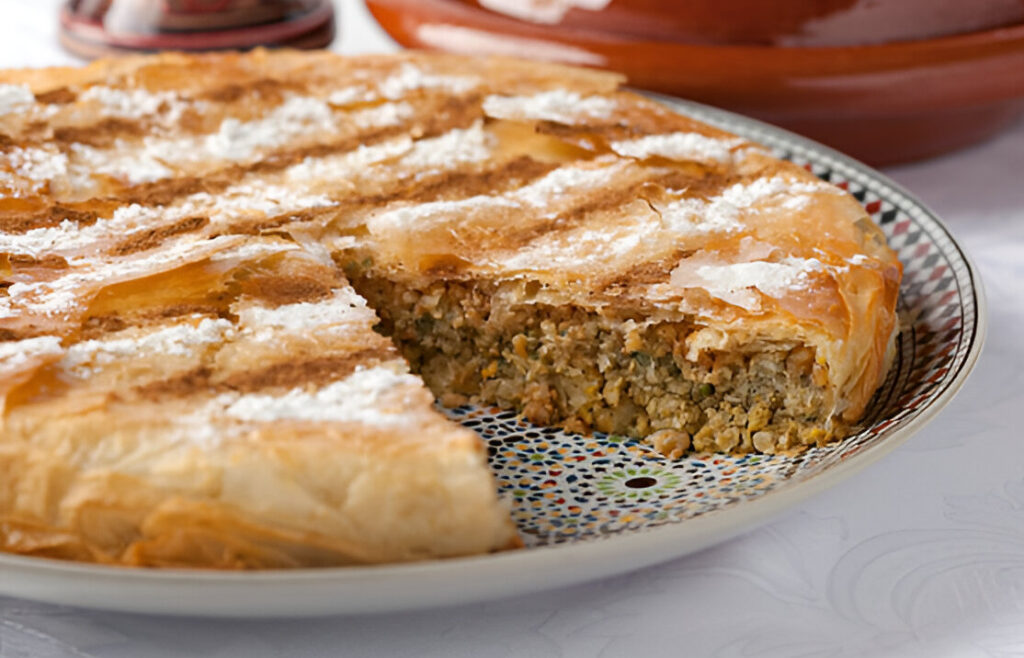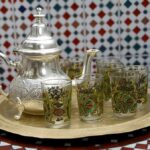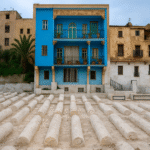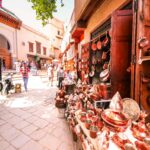
Delicious Moroccan Pastilla – A Sweet and Savory Culinary Icon
Imagine a dish that perfectly mixes sweet and savory tastes, all wrapped in flaky pastry. This is Pastilla, a key part of Moroccan cuisine.
Pastilla is more than food; it’s a way to connect with others. Making a Pastilla recipe is a tradition that shows the area’s rich culture.
As you dive into Pastilla, you’ll see why it’s loved everywhere. Its special taste and the skill needed to make it make it a true treat.
The Culinary Treasure of Morocco
In the heart of Moroccan cuisine lies a culinary treasure: Pastilla. This traditional dish is more than just a meal. It’s an experience that shows the rich cultural heritage and culinary expertise of Morocco.
Pastilla’s significance in Moroccan cuisine comes from its unique blend of flavors and textures. It’s made with layers of flaky pastry filled with meat, onions, and spices. This careful mix creates a harmonious taste experience.
The cultural importance of Pastilla is clear in its role at special occasions and celebrations. It’s often at the center of the table at weddings, holidays, or family reunions. Pastilla symbolizes hospitality and generosity, showing Morocco’s rich culinary traditions and history of cultural exchange.
Moroccan cuisine, with Pastilla as a highlight, is known worldwide for its diversity and richness. The dish’s popularity has grown, with food lovers around the globe enjoying its unique flavors and cultural significance.
In essence, Pastilla is not just a dish. It’s a representation of Moroccan hospitality and culinary art. Its preparation and presentation are filled with tradition, making it a true culinary treasure of Morocco.
The Rich History of Pastilla in Moroccan Cuisine
Pastilla’s origins are deeply rooted in Morocco’s rich culinary history. This traditional dish has a long history, showing the country’s cultural diversity. It reflects Morocco’s role as a crossroads between different civilizations.
Pastilla, also known as Bastilla, started in the medieval period. It was influenced by Mediterranean and Middle Eastern cuisines. Initially, it was a luxury for special occasions, served at royal courts and during big celebrations.
The evolution of Pastilla over time included new ingredients and cooking methods. This shows the multicultural influences on Moroccan cuisine. The dish became a symbol of hospitality and generosity in Moroccan culinary culture.
Historical records show Pastilla was made with layers of flaky pastry, meat (usually pigeon or chicken), and spices. It was topped with powdered sugar and cinnamon. This mix of sweet and savory flavors is unique to Moroccan cuisine, blending Arab, Berber, and Mediterranean influences.
As Moroccan cuisine evolved, Pastilla remained a favorite dish. It adapted to new tastes and ingredients while keeping its traditional essence. Today, it’s enjoyed worldwide, representing Moroccan culture through food.
The history of Pastilla highlights the dynamic and inclusive nature of Moroccan cuisine. It has been shaped by centuries of cultural exchange and culinary innovation.
Traditional Ingredients That Define Pastilla
At the heart of every Pastilla recipe are the traditional Moroccan ingredients. These ingredients give the dish its unique flavor and texture. The mix of these ingredients makes Pastilla stand out from other dishes.
The base of Pastilla is layers of flaky, buttery pastry, known as “warqa” or “phyllo dough.” This Moroccan pastry is key for the dish’s texture. It adds a delicate crunch that goes well with the soft fillings.
The fillings show off Pastilla’s true flavor. Traditionally, it’s filled with slow-cooked meat (usually chicken or pigeon), onions, and spices. The meat is cooked with spices like ginger, turmeric, and cinnamon, which are essential in Moroccan cooking.
Some versions also include eggs and cheese, adding richness and depth. The eggs are beaten and cooked with the meat, while the cheese is melted into the filling. This makes the dish even more flavorful.
The spice blend in Pastilla is a key feature. Spices like cumin, coriander, and cinnamon are used, giving the dish its distinct aroma and taste. The right balance of these spices is important for the dish’s complex flavors.
Finally, the topping of almonds and powdered sugar adds a sweet and crunchy contrast. This mix of flavors and textures is what makes traditional Pastilla so beloved in Moroccan cuisine.
In summary, Pastilla’s traditional ingredients, including flaky pastry, slow-cooked meat, spices, and a sweet topping, come together to create a masterpiece. Understanding these traditional Moroccan ingredients is essential to enjoying Pastilla’s richness.
Pastilla : Moroccan Cuisine’s Perfect Harmony of Flavors
The flavors in Pastilla show Morocco’s rich food history. This dish is a mix of sweet, savory, and spicy tastes. It’s a complex yet harmonious experience.
Layering Flavors: Pastilla’s layers are key to its taste. It starts with flaky warka or phyllo dough. Then, each layer adds something new. The filling, with meat, onions, and spices, is seasoned to perfection.
Almonds and spices add crunch and flavor. Spices like cinnamon, ginger, and turmeric are common in Moroccan food. They make Pastilla special.
Sweetness and Savory: Pastilla is known for its sweet and savory mix. Sugar, cinnamon, and dried fruits balance the savory meat and onions. This balance is a Moroccan cuisine hallmark.
The way Pastilla is made is just as important as its ingredients. Slow cooking blends the flavors, creating a rich taste. This care and tradition make Pastilla stand out in Moroccan food.
In short, Pastilla’s flavors show Morocco’s culinary sophistication. It’s a dish that layers ingredients and balances tastes for a unique dining experience.
Step-by-Step Guide to Making Authentic Pastilla
To enjoy Moroccan cuisine, you must learn to make Pastilla. This dish is famous for its flaky pastry and savory fillings. It’s a key part of Moroccan celebrations.
Preparing the Ingredients
First, gather all the ingredients you need. You’ll need layers of warqa or filo pastry, a filling (chicken or seafood), onions, garlic, ginger, and spices.
Chicken Pastilla Filling
For Chicken Pastilla, sauté chicken breast or thighs with onions, garlic, and spices. The mix includes ginger, cumin, and coriander. Cook until the chicken is done and the flavors blend well.
To make the filling, heat oil in a pan over medium heat. Add sliced onions and cook until they’re soft. Then, add minced garlic and grated ginger for a minute. Next, add the chicken, cut into small pieces, and cook until browned on all sides. Season with salt, pepper, and spices, and simmer until the chicken is fully cooked and the sauce thickens.
Seafood Pastilla Variation
For Seafood Pastilla, use a mix of seafood like shrimp, fish, and calamari. Cook it with garlic, onions, and spices for a seafood twist.
To prepare the seafood filling, sauté the mixed seafood with garlic, onions, and spices. Start by heating oil, then add minced garlic and sliced onions until the onions are soft. Add the seafood and cook until just done. Season with salt, pepper, and spices to taste. Be careful not to overcook the seafood to keep it tender and flavorful.
Assembling and Baking Pastilla
After preparing the filling, assemble the Pastilla. Layer the warqa or filo pastry with the filling, making sure it’s evenly spread and the pastry is sealed to prevent leakage during baking.
To assemble, brush a sheet of pastry with melted butter. Place a spoonful of filling in the center, leaving a border around the edges. Fold the pastry over the filling to form a square or circular shape, and press the edges to seal. Repeat with the remaining pastry and filling, brushing each layer with butter.
Once assembled, bake the Pastilla in a preheated oven until the pastry is golden brown and crispy. Keep an eye on it to avoid burning.
Tips for Authenticity
To make authentic Pastilla, use traditional ingredients and follow the recipe closely. The quality of the ingredients, especially the pastry, greatly affects the result.
Also, the balance of spices and the cooking time for the filling are key. The filling should be flavorful but not overcooked, and the pastry should be crispy and golden.
By following these steps and tips, you can make an authentic Pastilla that captures the essence of Moroccan cuisine. Whether for a special occasion or to explore new flavors, Pastilla is a delightful culinary adventure.
Exploring Pastilla Variations
Pastilla variations show how adaptable and creative Moroccan chefs are. Over time, Pastilla has evolved. Now, there are many different Pastilla recipes for all tastes.
One big change in Pastilla is the protein used. Instead of pigeon or chicken, you can find seafood, beef, or vegetarian options. This change meets the needs of more people and shows the dish’s flexibility.
Spices and herbs also get a creative twist in Pastilla variations. Some add saffron for luxury, while others use preserved lemons or olives for a tangy flavor. These touches show the creativity of Moroccan cuisine.
Presentation of Pastilla also varies. Chefs might serve it in individual portions or with creative garnishes. These different Pastilla recipes are not only delicious but also look great. They’re perfect for special events or dinner parties.
In summary, the world of Pastilla variations is full of possibilities. Whether you love traditional dishes or enjoy trying new things, exploring these recipes is a fun culinary adventure.
Pastilla in Moroccan Celebrations
Pastilla is a big deal in Moroccan culture, especially at big events. It’s a key dish at weddings, religious holidays, and other big gatherings. It shows unity and joy among everyone.
In Moroccan celebrations, Pastilla is often served as a sign of hospitality. It shows the country’s rich cultural heritage. Making Pastilla is a family affair, bringing people closer together.
The presence of Pastilla at these events is not just about the food; it’s about the tradition and the sense of community it fosters. It’s a staple at weddings, circumcision ceremonies, and Eid. Pastilla brings people together with its delicious flavors and smells.
Moroccan celebrations are full of life and warmth, and Pastilla is a big part of it. It’s usually the first dish served, setting the mood for the rest of the meal.
In short, Pastilla in Moroccan celebrations is a tradition that shows community, hospitality, and joy. Its role at big events highlights its importance in Moroccan culture and food.
Serving and Presentation Traditions
In Moroccan cuisine, how Pastilla is served and presented matters a lot. It shows the rich culture and hospitality of Moroccans.
Pastilla is often served as an appetizer or main course at special times. It’s garnished with powdered sugar and cinnamon. This makes the dish look and taste great.
The art of serving Pastilla is all about the arrangement. It’s placed in a pretty pattern on a platter or plates. This makes eating it more fun and memorable.
In Morocco, how Pastilla is presented changes with the occasion. At weddings and big gatherings, it’s made in fancy patterns. This adds to the joy of the event.
Serving Pastilla is a big part of Moroccan culture. It shows respect and care for guests. By presenting it nicely, hosts make the meal even more special.
Pairing Pastilla with Beverages
To fully enjoy Pastilla, picking the right drink is key. In Moroccan cuisine, drinks are vital for a great meal.
Moroccan Tea: A classic pick, Atay (Moroccan tea) goes well with Pastilla. Its minty taste matches the dish’s rich flavors. It’s more than taste; it’s a cultural bond.
Looking for something else? Try fresh juices like orange or pomegranate. They balance Pastilla’s richness with their acidity and sweetness.
Think about Pastilla’s ingredients when choosing a drink. If it’s spicy, a smooth tea or juice is better.
In Morocco, pairing drinks with food is a big part of the culture. The right drink can make your Pastilla meal unforgettable.
Where to Find Authentic Pastilla in the United States
Many food lovers in America search for real Pastilla. They look in Moroccan eateries and specialty stores. Finding authentic Pastilla is a fun food adventure.
In big cities like New York, Los Angeles, and Washington D.C., you can find Moroccan restaurants. These places serve Pastilla with traditional ingredients. Some famous Moroccan restaurants in the US are Aziza in San Francisco, Maroc in New York, and Sahara East in Las Vegas.
You can also find Pastilla or its ingredients in specialty food stores and markets. Middle Eastern and North African markets have many Moroccan foods, including Pastilla. Look for these in cities with big international markets, like New York’s Atlantic Avenue or Los Angeles’s West Adams Boulevard.
Online shopping is also an option. Many online stores and food delivery services sell authentic Pastilla or Moroccan meal kits. This makes it easy to enjoy Pastilla at home.
Whether you eat out or cook at home, you can find authentic Pastilla in the US. By looking for specialty restaurants and stores, or shopping online, you can enjoy this tasty and culturally rich dish.
Adapting Pastilla for American Kitchens
Bringing Moroccan flavors to your table is easy with Pastilla. Just swap hard-to-find ingredients for easier ones. This way, you keep the dish’s true taste.
Warqa, the Moroccan pastry, can be swapped with phyllo dough. You can find this in most supermarkets. It keeps the dish’s flaky, layered texture.
Using local ingredients is another smart move. Domestic spices and herbs can match Moroccan flavors. You can also use chicken or beef instead of traditional meats. This makes the dish easier to prepare.
These changes let American cooks enjoy Moroccan flavors without much effort. It brings a new twist to American cooking. This mix of cultures makes Pastilla more accessible and adds to American culinary traditions.
Bringing the Magic of Morocco to Your Table
Cooking Moroccan cuisine at home is a fun experience. Pastilla is a great dish to start with. It has rich flavors and layers that will impress everyone.
As you dive into Moroccan cuisine, you’ll find many dishes as interesting as Pastilla. Moroccan dishes are filled with aromatic spices and tender meats. They show off Morocco’s rich culture. Adding these recipes to your cooking will bring Morocco’s flavors to your table.
Whether you’re an experienced chef or new to cooking, Moroccan dishes are exciting to try. With basic ingredients and practice, you’ll soon cook like a Moroccan pro. So, why not start with Pastilla and then try other Moroccan dishes? You’ll love the magic of Moroccan cuisine at home.










